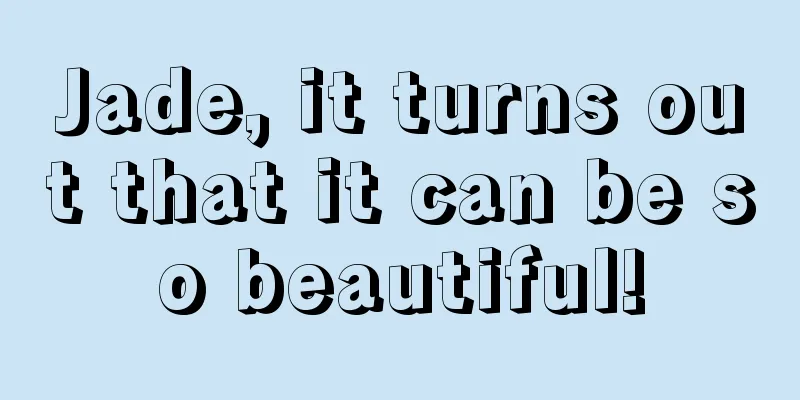Jade, it turns out that it can be so beautiful!

|
Jadeite, the noble "King of Jade", is a high-end jewelry that represents the East and is one of the seven major gemstones defined by the world jewelry industry. Its expensive price, rich and colorful colors, gorgeous yet steady tones, and reputation as a lucky gem all exude an alluring sense of mystery. Jade inlay is a skill that requires very high technical skills and a rare artistic treasure. The so-called inlay is a process of fixing jade on a bracket using various appropriate methods. The craftsmanship is delicate and complex, and emphasizes design texture and technical sophistication. The exquisite jade inlay craftsmanship combines Eastern classics with Western fashion elements, further highlighting the charm of jade. The luster of the metal blends harmoniously with the emerald green, further highlighting the material characteristics of the jewelry. With the combination and contrast of various materials, the entire piece of jewelry has a decorative art beauty! There are several theories about the origin of the name of jadeite. One theory is that it comes from the name of a bird. The feathers of this bird are very bright. The male's feathers are red, and it is called the jadeite bird (also known as the red-feathered bird). The female's feathers are green, and it is called the kingfisher (also known as the green-feathered bird). Together they are called jadeite, so there is a saying in the industry that jadeite is male and kingfisher is female. During the Ming Dynasty, after Burmese jade was introduced to China, it was named "jadeite". Another theory is that in ancient times "Cui" specifically referred to the green jade produced in Hotan, Xinjiang. After jadeite was introduced to China, in order to distinguish it from the green jade of Hotan, it was called "fei cui", and later gradually evolved into "jadeite". Common varieties include old pit jade, ice jade, water jade and more than a dozen other varieties. Jade has a vitreous luster and is translucent or transparent. Jade comes in a variety of colors due to the different coloring ions it contains: usually white, red, green and purple. Yellow, pink, etc. The pure one without impurities is white. If it contains chromium, it will appear soft and bright light green or dark green, which is called emerald. This variety is the most precious and is highly cherished and loved by people. If it contains manganese, it will appear light purple or dark purple, and is often called spring land or lotus root powder land. The beauty of jadeite inherits all kinds of beauty displayed by jade since ancient times. In addition to the beauty of the material itself and the personified "five virtues of jade", it also highlights the characteristics of color beauty, implicit beauty, mysterious beauty, and plasticity.
fruit fcgc33
|
>>: Have you ever appreciated such jade beauty?
Recommend
How is the jade carving technique?
Jade carving technology is an indispensable part ...
Can you identify jadeite? Teach you three little tips, it’s worth reading!
We have all kinds of knowledge about Nanhong jade...
What is the function of “water adjustment” of jade?
Water adjustment, an industry term, means adjusti...
When buying jadeite, should you choose the one with good quality or good color?
When purchasing jade jewelry, most people will fa...
Tips for Buying Jadeite
Gold in troubled times, jade in prosperous times....
The eight elegances of jade are warm and soothing to the heart. Which ones do you know?
Confucius said: The virtue of a gentleman is like...
Is it better to have jade inlaid or not inlaid? Everyone has their own preferences!
Reasons for liking jadeite inlay There are many w...
A jade melon is carved with three or two lines, just like a simple child.
The jadeite fortune melon is one of the simpler s...
A piece of jadeite scrap with a glutinous icy green base, carved with the word "enlightenment" in it, the finished product is extremely tempting!
The best jade rough materials are moist and trans...
Wearing the right jadeite for yourself will bring you good fortune. Which one is suitable for you?
Jade has always been regarded as the king of jade...
The principle of “simple is beautiful” also applies to jadeite!
The most famous quote in the history of world des...
People who like purple are elegant, really?
It is said that people who like purple are elegan...
Carving a "cicada" out of an ordinary jadeite stone, does it feel like jade carving is very simple?
Today I will show you the process of carving a &q...
The most practical analysis of jade market, a must-read for jade investment
There are two main types of Houjiang Stone. The f...
It may look inconspicuous despite its crystal clearness, but it is so expensive. How should you choose a jade ring?
Most of the articles we read on a daily basis are...









